Bizao, Rafael A; Machado, Leonardo D; de Sousa, Jose M; Pugno, Nicola M; Galvao, Douglas S
Scale Effects on the Ballistic Penetration of Graphene Sheets Journal Article
In: Nature Scientific Reports, vol. 8, pp. 6750, 2018.
@article{Bizao2018,
title = {Scale Effects on the Ballistic Penetration of Graphene Sheets},
author = {Bizao, Rafael A and Machado, Leonardo D and de Sousa, Jose M and Pugno, Nicola M and Galvao, Douglas S},
url = {https://www.nature.com/articles/s41598-018-25050-2},
doi = {doi:10.1038/s41598-018-25050-2},
year = {2018},
date = {2018-04-30},
journal = {Nature Scientific Reports},
volume = {8},
pages = {6750},
abstract = {Carbon nanostructures are promising ballistic protection materials, due to their low density and excellent mechanical properties. Recent experimental and computational investigations on the behavior of graphene under impact conditions revealed exceptional energy absorption properties as well. However, the reported numerical and experimental values differ by an order of magnitude. In this work, we combined numerical and analytical modeling to address this issue. In the numerical part, we employed reactive molecular dynamics to carry out ballistic tests on single, double, and triple-layered graphene sheets. We used velocity values within the range tested in experiments. Our numerical and the experimental results were used to determine parameters for a scaling law. We find that the specific penetration energy decreases as the number of layers (N) increases, from ∼15 MJ/kg for N = 1 to ∼0.9 MJ/kg for N = 350, for an impact velocity of 900 m/s. These values are in good agreement with simulations and experiments, within the entire range of N values for which data is presently available. Scale effects explain the apparent discrepancy between simulations and experiments.},
keywords = {},
pubstate = {published},
tppubtype = {article}
}
Leonardo D Machado Cristiano F Woellner, Pedro AS Autreto; Galvao, Douglas S
Structural Transformations of Carbon and Boron Nitride Nanoscrolls at High Impact Collisions Journal Article
In: Physical Chemistry Chemical Physics, vol. 20, pp. 4911-4916, 2018.
@article{Woellner2018,
title = {Structural Transformations of Carbon and Boron Nitride Nanoscrolls at High Impact Collisions},
author = {Cristiano F Woellner, Leonardo D Machado, Pedro AS Autreto, Jose M de Sousa, and Douglas S Galvao},
url = {http://pubs.rsc.org/en/content/articlelanding/2018/cp/c7cp07402f#!divAbstract},
doi = {DOI:10.1039/C7CP07402F},
year = {2018},
date = {2018-02-14},
journal = {Physical Chemistry Chemical Physics},
volume = {20},
pages = {4911-4916},
abstract = {The behavior of nanostructures under high strain-rate conditions has been the object of theoretical and
experimental investigations in recent years. For instance, it has been shown that carbon and boron
nitride nanotubes can be unzipped into nanoribbons at high-velocity impacts. However, the response of
many nanostructures to high strain-rate conditions is still unknown. In this work, we have investigated
the mechanical behavior of carbon (CNS) and boron nitride nanoscrolls (BNS) colliding against solid
targets at high velocities, using fully atomistic reactive (ReaxFF) molecular dynamics (MD) simulations.
CNS (BNS) are graphene (boron nitride) membranes rolled up into papyrus-like structures. Their openended
topology leads to unique properties not found in their close-ended analogs, such as nanotubes.
Our results show that collision products are mainly determined by impact velocities and by two
orientation angles, which define the position of the scroll (i) axis and (ii) open edge relative to the target.
Our MD results showed that for appropriate velocities and orientations, large-scale deformations and
nanoscroll fractures could occur. We also observed unscrolling (scrolls going back to quasi-planar
membranes), scroll unzipping into nanoribbons, and significant reconstruction due to breaking and/or
formation of new chemical bonds. For particular edge orientations and velocities, conversion from open
to close-ended topology is also possible, due to the fusion of nanoscroll walls.},
keywords = {},
pubstate = {published},
tppubtype = {article}
}
experimental investigations in recent years. For instance, it has been shown that carbon and boron
nitride nanotubes can be unzipped into nanoribbons at high-velocity impacts. However, the response of
many nanostructures to high strain-rate conditions is still unknown. In this work, we have investigated
the mechanical behavior of carbon (CNS) and boron nitride nanoscrolls (BNS) colliding against solid
targets at high velocities, using fully atomistic reactive (ReaxFF) molecular dynamics (MD) simulations.
CNS (BNS) are graphene (boron nitride) membranes rolled up into papyrus-like structures. Their openended
topology leads to unique properties not found in their close-ended analogs, such as nanotubes.
Our results show that collision products are mainly determined by impact velocities and by two
orientation angles, which define the position of the scroll (i) axis and (ii) open edge relative to the target.
Our MD results showed that for appropriate velocities and orientations, large-scale deformations and
nanoscroll fractures could occur. We also observed unscrolling (scrolls going back to quasi-planar
membranes), scroll unzipping into nanoribbons, and significant reconstruction due to breaking and/or
formation of new chemical bonds. For particular edge orientations and velocities, conversion from open
to close-ended topology is also possible, due to the fusion of nanoscroll walls.
Oliveira, Eliezer Fernando; Autreto, Pedro Alves da Silva; Galvao, Douglas Soares
On hardening silver nanocubes by high velocity impacts: a fully atomistic molecular dynamics investigation Journal Article
In: Journal of Materials Science, vol. 53, no. 10, pp. 7486–7492, 2018.
@article{Oliveira2018,
title = {On hardening silver nanocubes by high velocity impacts: a fully atomistic molecular dynamics investigation},
author = {Oliveira, Eliezer Fernando and Autreto, Pedro Alves da Silva and Galvao, Douglas Soares},
url = {https://link.springer.com/article/10.1007/s10853-018-2104-z},
doi = {10.1007/s10853-018-2104-z},
year = {2018},
date = {2018-02-09},
journal = {Journal of Materials Science},
volume = {53},
number = {10},
pages = {7486–7492},
abstract = {Gradient nanograins (GNG) creation in metals has been a promising approach to obtain ultra-strong materials. Recently, R. Thevamaran et al. (Science 354:312 in 2016) proposed a single-step method based on high-velocity impacts of silver nanocubes (SNC) to produce almost perfect GNG. However, after certain time, these grains spontaneously coalesce, which compromises the induced hardening and other mechanical properties. To better understand these processes, a detailed investigation at the atomic scale of the deformation/hardening mechanisms are needed, which is one of the objectives of the present work. We carried out fully atomistic molecular dynamics (MD) simulations of silver nanocubes at high impact velocity values using realistic structural models. Our MD results suggest that besides the GNG mechanisms, the observed SNC hardening could be also the result of the existence of polycrystalline arrangements formed by HCP domains encapsulated by FCC ones in the smashed SNC. This can be a new way to design ultra-strong materials, even in the absence of GNG domains.},
keywords = {},
pubstate = {published},
tppubtype = {article}
}
Oliveira, Eliezer Fernando; da Silva Autreto, Pedro Alves; Galvao, Douglas Soares
Silver Hardening via Hypersonic Impacts Journal Article
In: MRS Advances, vol. 3, no. 8-9, pp. 489-494, 2018.
@article{Oliveira2018b,
title = {Silver Hardening via Hypersonic Impacts},
author = {Eliezer Fernando Oliveira and Pedro Alves da Silva Autreto and Douglas Soares Galvao},
url = {https://www.cambridge.org/core/journals/mrs-advances/article/silver-hardening-via-hypersonic-impacts/6A35FAB117B4FD244BBD11A64CD25160},
doi = {DOI: 10.1557/adv.2018. 173},
year = {2018},
date = {2018-01-01},
journal = {MRS Advances},
volume = {3},
number = {8-9},
pages = {489-494},
abstract = {The search for new ultra strong materials has been a very active research area. With relation to metals, a successful way to improve their strength is by the creation of a gradient of nanograins (GNG) inside the material. Recently, R. Thevamaran et al. [Science v354, 312- 316 (2016)] propose a single step method based on high velocity impact of silver nanocubes to produce high-quality GNG. This method consists of producing high impact collisions of silver cubes at hypersonic velocity (~400 m/s) against a rigid wall. Although they observed an improvement in the mechanical properties of the silver after the impact, the GNG creation and the strengthening mechanism at nanoscale remain unclear. In order to gain further insights about these mechanisms, we carried out fully atomistic molecular dynamics simulations (MD) to investigate the atomic conformations/rearrangements during and after high impact collisions of silver nanocubes at ultrasonic velocity. Our results indicate the co- existence of polycrystalline arrangements after the impact formed by core HCP domains surrounded by FCC ones, which could also contribute to explain the structural hardening.},
keywords = {},
pubstate = {published},
tppubtype = {article}
}
Oliveira, Eliezer Fernando; Pedro Alves da Silva Autreto,; Galvao, Douglas Soares
Silver Hardening via Hypersonic Impacts Online
2017, (preprint arXiv:1801.04780).
@online{Oliveira2017,
title = {Silver Hardening via Hypersonic Impacts},
author = {Eliezer Fernando Oliveira and Pedro Alves da Silva Autreto, and Douglas Soares Galvao},
url = {https://arxiv.org/abs/1801.04780},
year = {2017},
date = {2017-01-15},
abstract = {The search for new ultra strong materials has been a very active research area. With relation
to metals, a successful way to improve their strength is by the creation of a gradient of
nanograins (GNG) inside the material. Recently, R. Thevamaran et al. [Science v354, 312-
316 (2016)] propose a single step method based on high velocity impact of silver nanocubes
to produce high-quality GNG. This method consists of producing high impact collisions of
silver cubes at hypersonic velocity (~400 m/s) against a rigid wall. Although they observed an
improvement in the mechanical properties of the silver after the impact, the GNG creation
and the strengthening mechanism at nanoscale remain unclear. In order to gain further
insights about these mechanisms, we carried out fully atomistic molecular dynamics
simulations (MD) to investigate the atomic conformations/rearrangements during and after
high impact collisions of silver nanocubes at ultrasonic velocity. Our results indicate the coexistence
of polycrystalline arrangements after the impact formed by core HCP domains
surrounded by FCC ones, which could also contribute to explain the structural hardening.},
note = {preprint arXiv:1801.04780},
keywords = {},
pubstate = {published},
tppubtype = {online}
}
to metals, a successful way to improve their strength is by the creation of a gradient of
nanograins (GNG) inside the material. Recently, R. Thevamaran et al. [Science v354, 312-
316 (2016)] propose a single step method based on high velocity impact of silver nanocubes
to produce high-quality GNG. This method consists of producing high impact collisions of
silver cubes at hypersonic velocity (~400 m/s) against a rigid wall. Although they observed an
improvement in the mechanical properties of the silver after the impact, the GNG creation
and the strengthening mechanism at nanoscale remain unclear. In order to gain further
insights about these mechanisms, we carried out fully atomistic molecular dynamics
simulations (MD) to investigate the atomic conformations/rearrangements during and after
high impact collisions of silver nanocubes at ultrasonic velocity. Our results indicate the coexistence
of polycrystalline arrangements after the impact formed by core HCP domains
surrounded by FCC ones, which could also contribute to explain the structural hardening.
2018
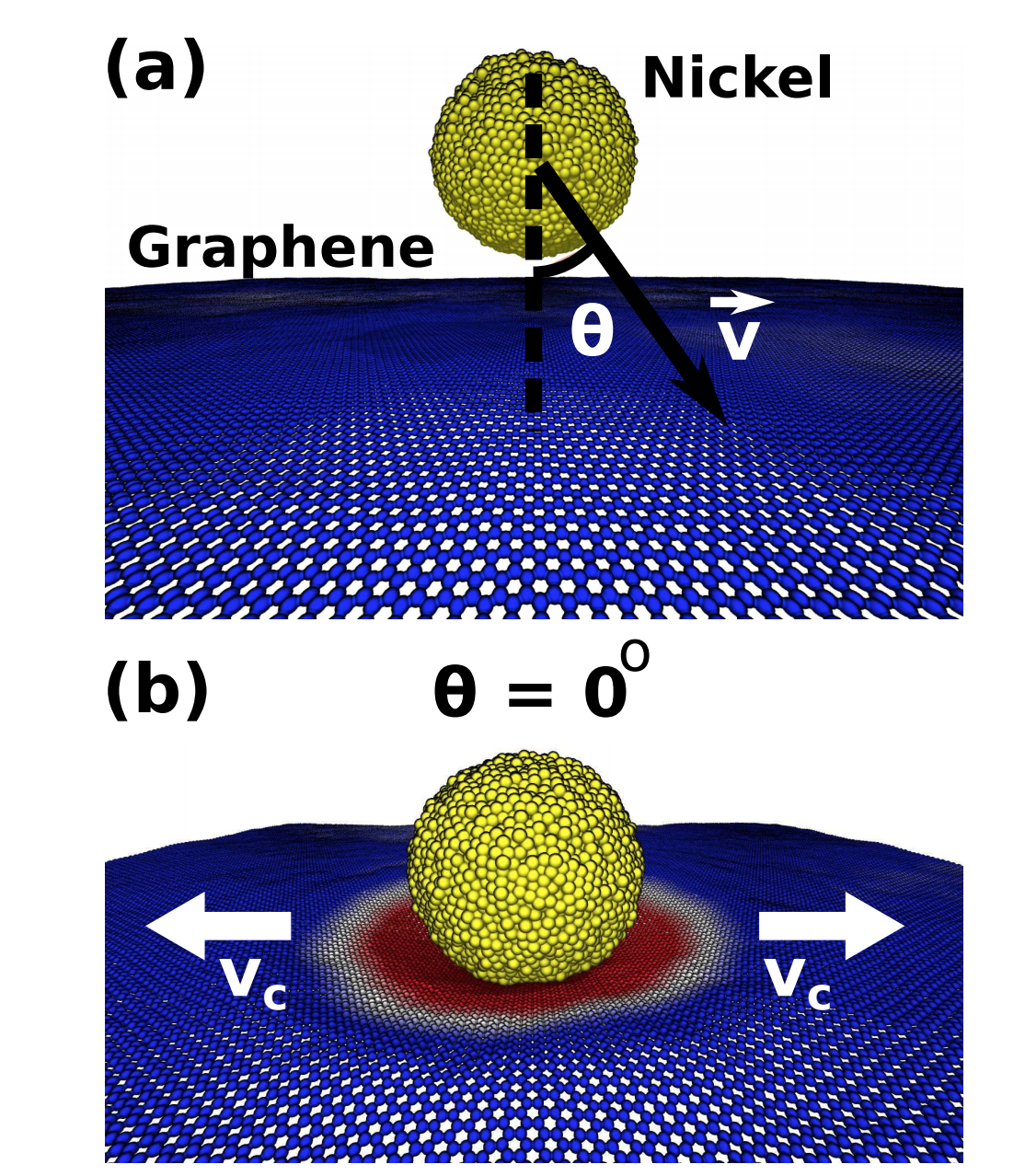
Bizao, Rafael A; Machado, Leonardo D; de Sousa, Jose M; Pugno, Nicola M; Galvao, Douglas S
Scale Effects on the Ballistic Penetration of Graphene Sheets Journal Article
In: Nature Scientific Reports, vol. 8, pp. 6750, 2018.
Abstract | Links | BibTeX | Tags: Fracture, Graphene, impact, Molecular Dynamics
@article{Bizao2018,
title = {Scale Effects on the Ballistic Penetration of Graphene Sheets},
author = {Bizao, Rafael A and Machado, Leonardo D and de Sousa, Jose M and Pugno, Nicola M and Galvao, Douglas S},
url = {https://www.nature.com/articles/s41598-018-25050-2},
doi = {doi:10.1038/s41598-018-25050-2},
year = {2018},
date = {2018-04-30},
journal = {Nature Scientific Reports},
volume = {8},
pages = {6750},
abstract = {Carbon nanostructures are promising ballistic protection materials, due to their low density and excellent mechanical properties. Recent experimental and computational investigations on the behavior of graphene under impact conditions revealed exceptional energy absorption properties as well. However, the reported numerical and experimental values differ by an order of magnitude. In this work, we combined numerical and analytical modeling to address this issue. In the numerical part, we employed reactive molecular dynamics to carry out ballistic tests on single, double, and triple-layered graphene sheets. We used velocity values within the range tested in experiments. Our numerical and the experimental results were used to determine parameters for a scaling law. We find that the specific penetration energy decreases as the number of layers (N) increases, from ∼15 MJ/kg for N = 1 to ∼0.9 MJ/kg for N = 350, for an impact velocity of 900 m/s. These values are in good agreement with simulations and experiments, within the entire range of N values for which data is presently available. Scale effects explain the apparent discrepancy between simulations and experiments.},
keywords = {Fracture, Graphene, impact, Molecular Dynamics},
pubstate = {published},
tppubtype = {article}
}
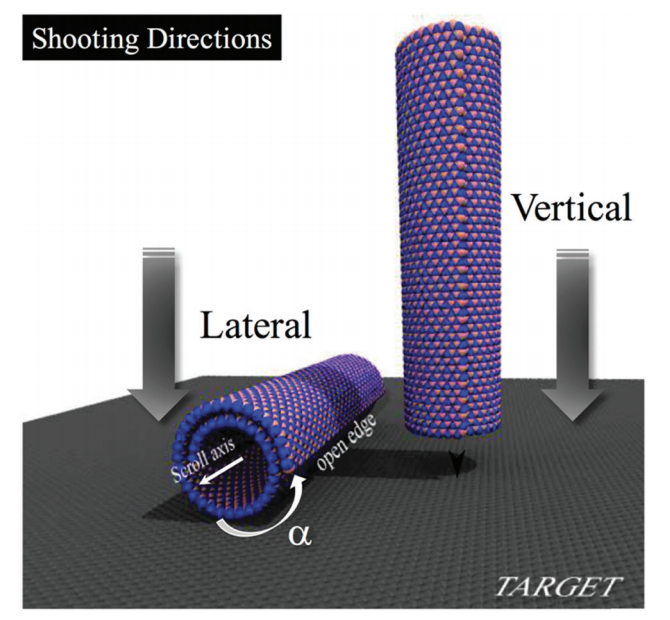
Leonardo D Machado Cristiano F Woellner, Pedro AS Autreto; Galvao, Douglas S
Structural Transformations of Carbon and Boron Nitride Nanoscrolls at High Impact Collisions Journal Article
In: Physical Chemistry Chemical Physics, vol. 20, pp. 4911-4916, 2018.
Abstract | Links | BibTeX | Tags: Fracture, impact, Molecular Dynamics, scroll
@article{Woellner2018,
title = {Structural Transformations of Carbon and Boron Nitride Nanoscrolls at High Impact Collisions},
author = {Cristiano F Woellner, Leonardo D Machado, Pedro AS Autreto, Jose M de Sousa, and Douglas S Galvao},
url = {http://pubs.rsc.org/en/content/articlelanding/2018/cp/c7cp07402f#!divAbstract},
doi = {DOI:10.1039/C7CP07402F},
year = {2018},
date = {2018-02-14},
journal = {Physical Chemistry Chemical Physics},
volume = {20},
pages = {4911-4916},
abstract = {The behavior of nanostructures under high strain-rate conditions has been the object of theoretical and
experimental investigations in recent years. For instance, it has been shown that carbon and boron
nitride nanotubes can be unzipped into nanoribbons at high-velocity impacts. However, the response of
many nanostructures to high strain-rate conditions is still unknown. In this work, we have investigated
the mechanical behavior of carbon (CNS) and boron nitride nanoscrolls (BNS) colliding against solid
targets at high velocities, using fully atomistic reactive (ReaxFF) molecular dynamics (MD) simulations.
CNS (BNS) are graphene (boron nitride) membranes rolled up into papyrus-like structures. Their openended
topology leads to unique properties not found in their close-ended analogs, such as nanotubes.
Our results show that collision products are mainly determined by impact velocities and by two
orientation angles, which define the position of the scroll (i) axis and (ii) open edge relative to the target.
Our MD results showed that for appropriate velocities and orientations, large-scale deformations and
nanoscroll fractures could occur. We also observed unscrolling (scrolls going back to quasi-planar
membranes), scroll unzipping into nanoribbons, and significant reconstruction due to breaking and/or
formation of new chemical bonds. For particular edge orientations and velocities, conversion from open
to close-ended topology is also possible, due to the fusion of nanoscroll walls.},
keywords = {Fracture, impact, Molecular Dynamics, scroll},
pubstate = {published},
tppubtype = {article}
}
experimental investigations in recent years. For instance, it has been shown that carbon and boron
nitride nanotubes can be unzipped into nanoribbons at high-velocity impacts. However, the response of
many nanostructures to high strain-rate conditions is still unknown. In this work, we have investigated
the mechanical behavior of carbon (CNS) and boron nitride nanoscrolls (BNS) colliding against solid
targets at high velocities, using fully atomistic reactive (ReaxFF) molecular dynamics (MD) simulations.
CNS (BNS) are graphene (boron nitride) membranes rolled up into papyrus-like structures. Their openended
topology leads to unique properties not found in their close-ended analogs, such as nanotubes.
Our results show that collision products are mainly determined by impact velocities and by two
orientation angles, which define the position of the scroll (i) axis and (ii) open edge relative to the target.
Our MD results showed that for appropriate velocities and orientations, large-scale deformations and
nanoscroll fractures could occur. We also observed unscrolling (scrolls going back to quasi-planar
membranes), scroll unzipping into nanoribbons, and significant reconstruction due to breaking and/or
formation of new chemical bonds. For particular edge orientations and velocities, conversion from open
to close-ended topology is also possible, due to the fusion of nanoscroll walls.
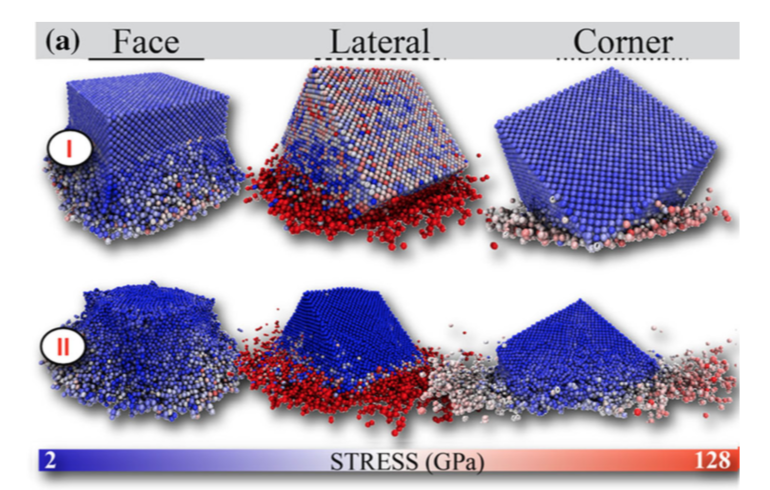
Oliveira, Eliezer Fernando; Autreto, Pedro Alves da Silva; Galvao, Douglas Soares
On hardening silver nanocubes by high velocity impacts: a fully atomistic molecular dynamics investigation Journal Article
In: Journal of Materials Science, vol. 53, no. 10, pp. 7486–7492, 2018.
Abstract | Links | BibTeX | Tags: Fracture, impact, Molecular Dynamics, silver
@article{Oliveira2018,
title = {On hardening silver nanocubes by high velocity impacts: a fully atomistic molecular dynamics investigation},
author = {Oliveira, Eliezer Fernando and Autreto, Pedro Alves da Silva and Galvao, Douglas Soares},
url = {https://link.springer.com/article/10.1007/s10853-018-2104-z},
doi = {10.1007/s10853-018-2104-z},
year = {2018},
date = {2018-02-09},
journal = {Journal of Materials Science},
volume = {53},
number = {10},
pages = {7486–7492},
abstract = {Gradient nanograins (GNG) creation in metals has been a promising approach to obtain ultra-strong materials. Recently, R. Thevamaran et al. (Science 354:312 in 2016) proposed a single-step method based on high-velocity impacts of silver nanocubes (SNC) to produce almost perfect GNG. However, after certain time, these grains spontaneously coalesce, which compromises the induced hardening and other mechanical properties. To better understand these processes, a detailed investigation at the atomic scale of the deformation/hardening mechanisms are needed, which is one of the objectives of the present work. We carried out fully atomistic molecular dynamics (MD) simulations of silver nanocubes at high impact velocity values using realistic structural models. Our MD results suggest that besides the GNG mechanisms, the observed SNC hardening could be also the result of the existence of polycrystalline arrangements formed by HCP domains encapsulated by FCC ones in the smashed SNC. This can be a new way to design ultra-strong materials, even in the absence of GNG domains.},
keywords = {Fracture, impact, Molecular Dynamics, silver},
pubstate = {published},
tppubtype = {article}
}
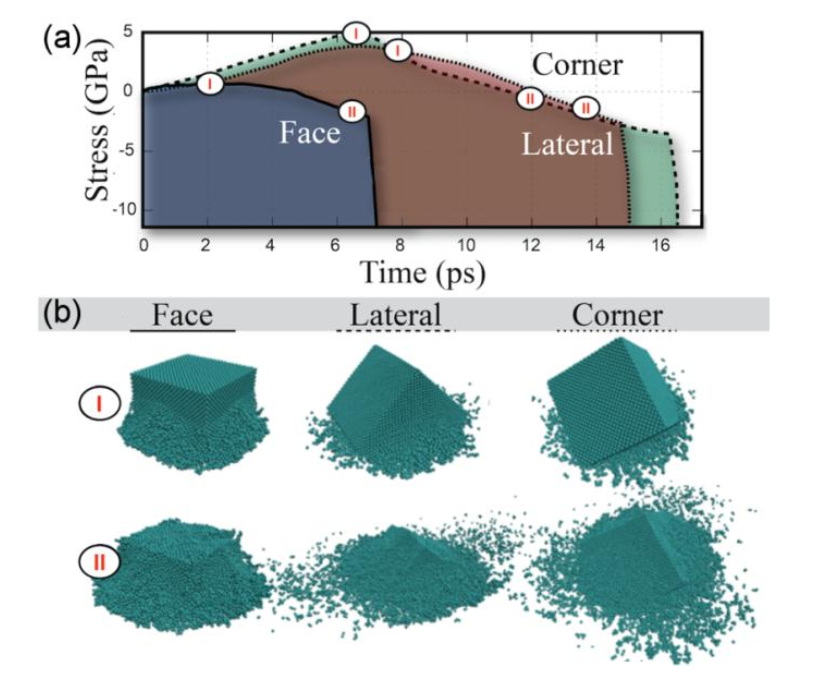
Oliveira, Eliezer Fernando; da Silva Autreto, Pedro Alves; Galvao, Douglas Soares
Silver Hardening via Hypersonic Impacts Journal Article
In: MRS Advances, vol. 3, no. 8-9, pp. 489-494, 2018.
Abstract | Links | BibTeX | Tags: Fracture, impact, Molecular Dynamics, silver
@article{Oliveira2018b,
title = {Silver Hardening via Hypersonic Impacts},
author = {Eliezer Fernando Oliveira and Pedro Alves da Silva Autreto and Douglas Soares Galvao},
url = {https://www.cambridge.org/core/journals/mrs-advances/article/silver-hardening-via-hypersonic-impacts/6A35FAB117B4FD244BBD11A64CD25160},
doi = {DOI: 10.1557/adv.2018. 173},
year = {2018},
date = {2018-01-01},
journal = {MRS Advances},
volume = {3},
number = {8-9},
pages = {489-494},
abstract = {The search for new ultra strong materials has been a very active research area. With relation to metals, a successful way to improve their strength is by the creation of a gradient of nanograins (GNG) inside the material. Recently, R. Thevamaran et al. [Science v354, 312- 316 (2016)] propose a single step method based on high velocity impact of silver nanocubes to produce high-quality GNG. This method consists of producing high impact collisions of silver cubes at hypersonic velocity (~400 m/s) against a rigid wall. Although they observed an improvement in the mechanical properties of the silver after the impact, the GNG creation and the strengthening mechanism at nanoscale remain unclear. In order to gain further insights about these mechanisms, we carried out fully atomistic molecular dynamics simulations (MD) to investigate the atomic conformations/rearrangements during and after high impact collisions of silver nanocubes at ultrasonic velocity. Our results indicate the co- existence of polycrystalline arrangements after the impact formed by core HCP domains surrounded by FCC ones, which could also contribute to explain the structural hardening.},
keywords = {Fracture, impact, Molecular Dynamics, silver},
pubstate = {published},
tppubtype = {article}
}
2017
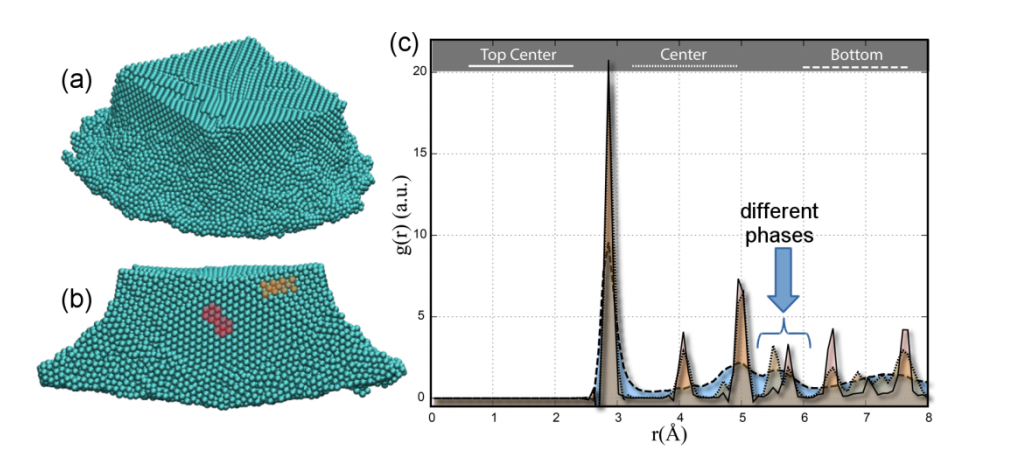
Oliveira, Eliezer Fernando; Pedro Alves da Silva Autreto,; Galvao, Douglas Soares
Silver Hardening via Hypersonic Impacts Online
2017, (preprint arXiv:1801.04780).
Abstract | Links | BibTeX | Tags: Fracture, impact, Molecular Dynamics, silver
@online{Oliveira2017,
title = {Silver Hardening via Hypersonic Impacts},
author = {Eliezer Fernando Oliveira and Pedro Alves da Silva Autreto, and Douglas Soares Galvao},
url = {https://arxiv.org/abs/1801.04780},
year = {2017},
date = {2017-01-15},
abstract = {The search for new ultra strong materials has been a very active research area. With relation
to metals, a successful way to improve their strength is by the creation of a gradient of
nanograins (GNG) inside the material. Recently, R. Thevamaran et al. [Science v354, 312-
316 (2016)] propose a single step method based on high velocity impact of silver nanocubes
to produce high-quality GNG. This method consists of producing high impact collisions of
silver cubes at hypersonic velocity (~400 m/s) against a rigid wall. Although they observed an
improvement in the mechanical properties of the silver after the impact, the GNG creation
and the strengthening mechanism at nanoscale remain unclear. In order to gain further
insights about these mechanisms, we carried out fully atomistic molecular dynamics
simulations (MD) to investigate the atomic conformations/rearrangements during and after
high impact collisions of silver nanocubes at ultrasonic velocity. Our results indicate the coexistence
of polycrystalline arrangements after the impact formed by core HCP domains
surrounded by FCC ones, which could also contribute to explain the structural hardening.},
note = {preprint arXiv:1801.04780},
keywords = {Fracture, impact, Molecular Dynamics, silver},
pubstate = {published},
tppubtype = {online}
}
to metals, a successful way to improve their strength is by the creation of a gradient of
nanograins (GNG) inside the material. Recently, R. Thevamaran et al. [Science v354, 312-
316 (2016)] propose a single step method based on high velocity impact of silver nanocubes
to produce high-quality GNG. This method consists of producing high impact collisions of
silver cubes at hypersonic velocity (~400 m/s) against a rigid wall. Although they observed an
improvement in the mechanical properties of the silver after the impact, the GNG creation
and the strengthening mechanism at nanoscale remain unclear. In order to gain further
insights about these mechanisms, we carried out fully atomistic molecular dynamics
simulations (MD) to investigate the atomic conformations/rearrangements during and after
high impact collisions of silver nanocubes at ultrasonic velocity. Our results indicate the coexistence
of polycrystalline arrangements after the impact formed by core HCP domains
surrounded by FCC ones, which could also contribute to explain the structural hardening.
http://scholar.google.com/citations?hl=en&user=95SvbM8AAAAJ


